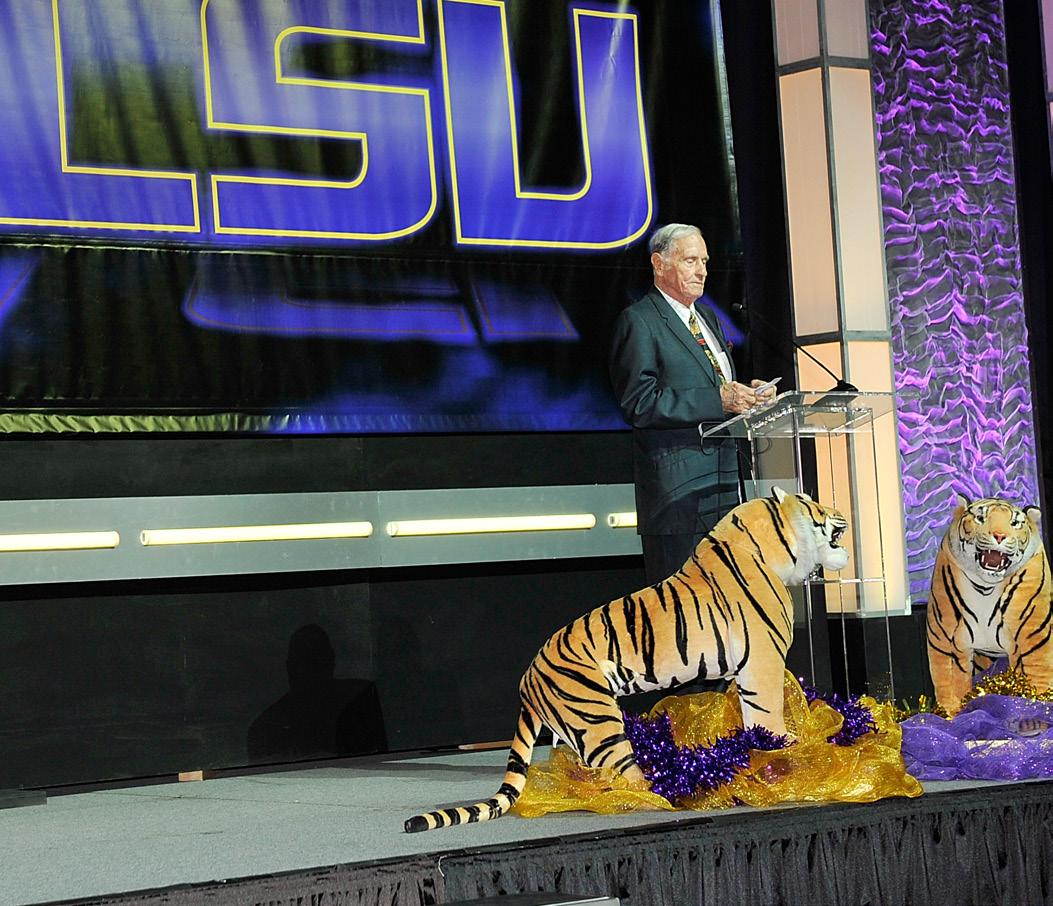
3 minute read
Bob Pettit
Bob Pettit once said of himself as a youngster who would grow up to be a collegiate AllAmerican and a force in the National Basketball Association:
Being terrible meant being gangly and not very good. He was tall, but he wasn’t able to yet make the moves that made him a future star. He was the last man on the junior varsity his freshman year at Baton Rouge High. As a sophomore, he was cut from the varsity. But because of that, he took his interest in basketball to heart and began to work hour- after-hour in back of the house in Baton Rouge.
As a 6-4 junior, he began to be noticed. His skills were still raw and undeveloped, but his size made him worth a second glance. He grew to 6-7 as a junior, and BRHS won the state championship.
Pettit once wrote: “Teammates. . .were miles ahead of me in all-around ability, but college scouts gave me the big rush act because I was six-seven by then. Fifteen schools offered me the standard scholarship.”
LSU fans loved what they saw in Pettit, and he didn’t disappoint. Here was a three-time FirstTeam All-SEC member who led his Tigers to a second place finish in 1952, conference titles in 1953 and 1954 and the NCAA Final Four in 1953.
He led the league in scoring all three years, with the highest averages seen to date in the league: 25.5 points in 1952, 24.9 in 1953 and 31.4 points per game in 1954. At the same time, he was averaging 13.1 (1952), 13.9 (1953) and an LSU best 17.3 (1954) rebounds per game. Only Pete Maravich and Chris Jackson would also break the 30-point average barrier at LSU.
Coach Cliff Wells of Tulane summed up Bob Pettit’s days at LSU, “He’s the best big man in college basketball today, and I’ve seen them all.” LSU Coach Harry Rabenhorst called him, “the greatest LSU player since Sparky Wade.”
He was a first round draft choice in 1954 of the then Milwaukee Hawks. Pettit played his entire 11-year career with the Hawks, moving with the club to St. Louis in 1955. He wrote nearly every record in the Hawks’ record book and was a four-time MVP of the annual NBA AllStar game. He led the Hawks to the 1958 NBA Championship and five NBA Finals.
In 1954, his number 50 was retired at LSU, the first number in any sport retired in Tiger Town. In 1964, he became the first NBA player to exceed the 20,000-points scored barrier. In 1970, he was elected to the Basketball Hall of Fame and in 2006 to the National Collegiate Basketball Hall of Fame.
In 2009, he was honored again by the school he loved and continues to support as he was named one of the members of LSU’s “AllCentury Team.”
Pettit still lives in South Louisiana and can be seen several times a season watching his Tigers play at the Maravich Center. He was back for a special weekend in 2013, honoring the 60th anniversary of the LSU 1953 NCAA Final Four team.
In February 2016, Pettit and his family unveiled a statue in front of the LSU Practice Facility at the Pete Maravich Assembly Center forever honoring his great basketball accomplishments.
LSU All-American 1953, 1954
First LSU Player to Have Number Retired 1954
Member of Naismith Basketball Hall of Fame 1971
Member of NBA 50-Year Top 50 1997
Member of LSWA Top 25 Louisiana Athletes of the Century 1999
Member First-Team LABC AllLouisiana Team of the Century 1999
1999 Living Legend for LSU at SEC Basketball Tournament
Member National Collegiate Basketball Hall of Fame 2006
Member of LSU’s “All Century Team” 2009
Pettit statue dedicated in front of PMAC practice facilty, February 2016
Pettit’s Career Statistics
YEAR
GMS FGM FGA PCT. FTM FTA PCT. REB. PTS. AVG. 1951-52 24 247 563 .439 118 199 .593 315 612 25.5 1952-53 21 193 133 217 .613 292 519 24.7 1953-54 25 281 573 .489 223 308 .740 432 785 31.4 TOTALS 70 721 474 724 .655 1039 1916 27.4










